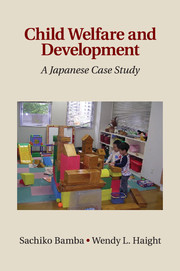Book contents
- Frontmatter
- Contents
- Tables and Figures
- Acknowledgments
- 1 Child-rearing at a Residential Child Care Institution
- 2 Japanese Contexts and Concepts
- 3 The Research Program
- 4 A Developmental Goal for Maltreated Children
- 5 Challenges to Maltreated Children’s Ibasho Creation
- 6 Socialization Practices Underlying Ibasho Creation
- 7 Children’s Lives and Experiences of Ibasho and Mimamori
- 8 Mr. Watanabe’s Responses to the Intervention
- 9 Reflections on Some Challenges of Field Research
- 10 The Emerging Child Welfare Context of Jidou Yougo Shisetsu
- 11 Conclusion: Some Lessons for Culturally Sensitive Child Welfare
- References
- Index
1 - Child-rearing at a Residential Child Care Institution
Watching with Long Eyes
Published online by Cambridge University Press: 07 October 2011
- Frontmatter
- Contents
- Tables and Figures
- Acknowledgments
- 1 Child-rearing at a Residential Child Care Institution
- 2 Japanese Contexts and Concepts
- 3 The Research Program
- 4 A Developmental Goal for Maltreated Children
- 5 Challenges to Maltreated Children’s Ibasho Creation
- 6 Socialization Practices Underlying Ibasho Creation
- 7 Children’s Lives and Experiences of Ibasho and Mimamori
- 8 Mr. Watanabe’s Responses to the Intervention
- 9 Reflections on Some Challenges of Field Research
- 10 The Emerging Child Welfare Context of Jidou Yougo Shisetsu
- 11 Conclusion: Some Lessons for Culturally Sensitive Child Welfare
- References
- Index
Summary
As a result of his single mother’s financial and work-related struggles, three-year-old Masaru was placed in a residential child care institution, one of many Japanese facilities for children who for a variety of reasons cannot live with their families. Several months later, Masaru’s mother married and brought him home to his new family. His mother, however, had mental health problems, and his new stepfather, a member of the Japanese mob, did not want him. Soon after he returned home, Masaru’s stepfather began physically abusing him and also exposed him to adult criminality. Over time, Masaru developed serious behavioral problems, including fighting with his peers. When he was eight years old, his mother sought help from a child guidance center. Such centers are accessible throughout Japan to provide services and referrals for a range of child-rearing and developmental issues. After consulting with staff members, Masaru’s mother again decided to place him in a residential child care institution. He lived there for two years before reuniting with his family. Unfortunately, family problems persisted, and Masaru’s mother again sought help. This time, Masaru, now age thirteen, was placed in the Children’s Academy, a residential child care institution and primary site of our research.
- Type
- Chapter
- Information
- Child Welfare and DevelopmentA Japanese Case Study, pp. 1 - 15Publisher: Cambridge University PressPrint publication year: 2011



